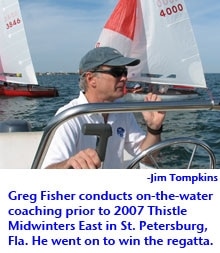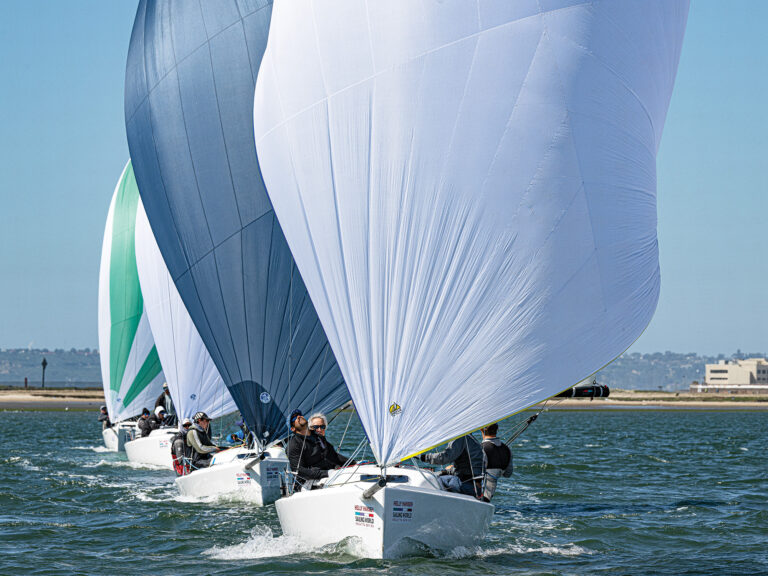
FisherFirstBeatSt
For the second straight year-and the eighth in the last 20-Greg Fisher won Thistle Midwinters East in St. Petersburg, Fla. And as always, he did so kindly, nurturing an unflagging consideration for his fellow sailors. With the help of his wife, JoAnn, and longtime collaborator Jeff Eiber, Fisher put together a near flawless series, never finishing lower than seventh, and more importantly, never compromising the respect of his competition. Fisher also participated in Coach TCA, an innovative mentoring program through which the class’ top skippers buddy up with less experienced skippers and crews for classroom discussions and on-the-water coaching. In this added role of Thistle Class guru, Fisher proves no less capable. His patience fielding questions in the parking lot is matched only by his patience picking lanes on the first beat. I spoke with Fisher as he was rigging up for Flying Scot Midwinters, also taking place in St. Pete. You sailed a very consistent regatta in very inconsistent conditions. How’d you do it? Well, I think we had good boatspeed, and good gear changing capabilities, and I’m really happy with our team and the way we’re set up. And because of that, because we had confidence in our speed, we were able to stick to fairly conservative tactics. We never got too far out to one side of the fleet, unless we had a very good reason, whether the current was doing something, or if there was velocity on the right. If I we weren’t positive, though, we’d work the middle and rely on our good speed to make gains.During one of the Coach TCA sessions, you advised that, when digging back from deep in the fleet, it’s better to make smaller gains in the middle rather than try to gain back all the boats at once by banging a corner. People have this tendency, and I do, too: When you have a lousy start and get tacked on and have to bail out, you sail towards a corner to find a clear lane. What works better, when I’ve had a bad start and I’m trying to work my way out, I’ll work real hard to find a lane on the inside, rather than going out to the sides. We’ll just try to hang in there and work the middle until we see that one side is working better for the gang. When you’re hanging it out on the corner, you don’t always have the option to take advantage of the shifts. Finding a clear lane in the middle, especially when you’re back in the pack, can be easier said than done. What are the realities of this approach?First off, if you’re trying to work the middle, you can’t be so picky about your lanes. Sometimes you have to go with one that isn’t ideal. In that case, we’ll try to just hang in there for 30 seconds or a minute. Look at it this way: we’re living in an area that’s not as perfect as we might like, but that’s the compromise we make to get back in off the sides. The pecking order established itself pretty early in the regatta, with you in the lead, Paul Abdullah in second, and Robby Brown in third. Do you sail differently when you’re trying to protect a lead?I don’t think so. Once we get deeper into a regatta and it’s obvious who we’re competing against, we try to know where they are all the time. Last week, we always knew where Paul, Robby, and Greg Griffin were. It wasn’t an “Oh boy, we’ve got to get over and guard them.” It was more, “Gee, I wonder why they’re over there.” Later in the week, we made sure to not get too far out of touch with them. For sure, the last race [sailed in 25-knot breeze] we just stayed as close to Paul as possible, and we were careful about not pressing it too hard. We didn’t want to risk flipping over. In the Thistle Class, there can be a pretty big disparity between the top sailors and the back of the pack. As a North Sails representative sailing against your customers, do you try to be on your best behavior?You know, it’s not so much the business part of it, being a sailmaker. I feel it’s our job as the people who have been sailing awhile and are doing well, it’s our job to try to be as kind to the people coming up through the ranks as we’d want them to be to us. As far as tacking on guys and things like that, unless we’re stuck in a situation and we have to tack right in a particular spot-there’s a starboard tacker coming or something- we try not to squat on anybody. There were times last week when we tacked on somebody pretty hard, and I went up to them after the race and said, “Hey man, I wasn’t trying to lay one on you or anything.” It seems like that’s the policy with most skippers in the fleet.I will say, I’ve had the opportunity to sail with a lot of classes, and the Thistle group is one of the cleanest and fairest around. Not that other groups don’t abide by the rules or anything like that, but that Thistle sailors are the most conscious of the rest of the fleet’s feelings, so to speak. And that’s good. It’s important. It makes the class what it is. That’s why the class keeps growing. You see these new faces come in, and they have such a good time at the regattas it keeps them coming back.
For complete results from 2007 Thistle Midwinters East, click here.









